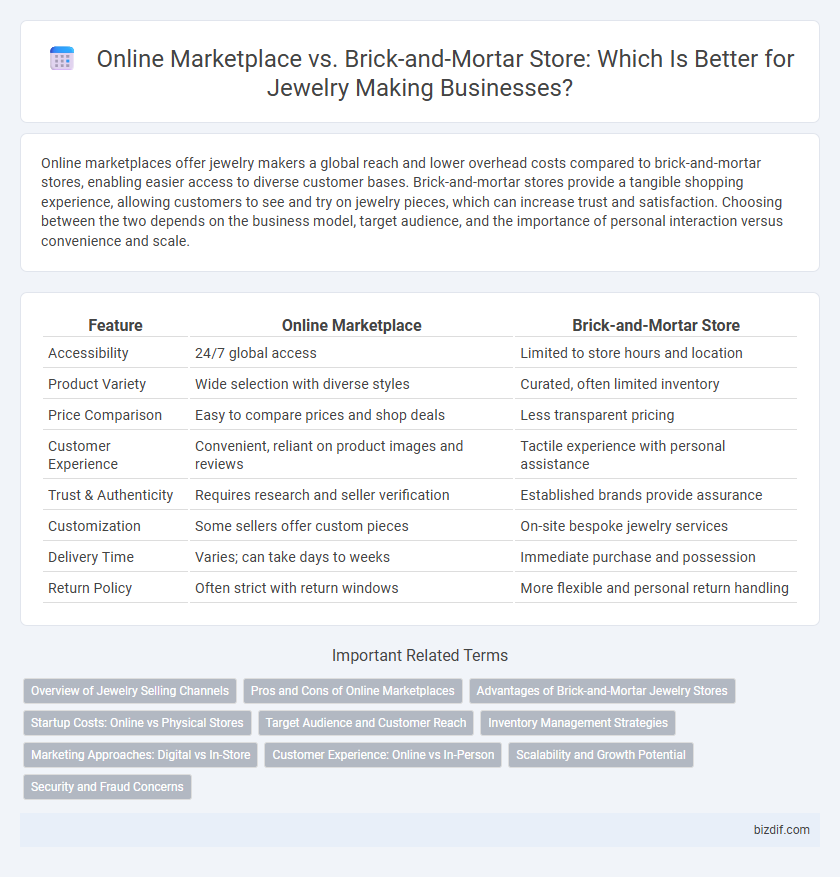Online marketplaces offer jewelry makers a global reach and lower overhead costs compared to brick-and-mortar stores, enabling easier access to diverse customer bases. Brick-and-mortar stores provide a tangible shopping experience, allowing customers to see and try on jewelry pieces, which can increase trust and satisfaction. Choosing between the two depends on the business model, target audience, and the importance of personal interaction versus convenience and scale.
Table of Comparison
| Feature | Online Marketplace | Brick-and-Mortar Store |
|---|---|---|
| Accessibility | 24/7 global access | Limited to store hours and location |
| Product Variety | Wide selection with diverse styles | Curated, often limited inventory |
| Price Comparison | Easy to compare prices and shop deals | Less transparent pricing |
| Customer Experience | Convenient, reliant on product images and reviews | Tactile experience with personal assistance |
| Trust & Authenticity | Requires research and seller verification | Established brands provide assurance |
| Customization | Some sellers offer custom pieces | On-site bespoke jewelry services |
| Delivery Time | Varies; can take days to weeks | Immediate purchase and possession |
| Return Policy | Often strict with return windows | More flexible and personal return handling |
Overview of Jewelry Selling Channels
Jewelry selling channels encompass online marketplaces and brick-and-mortar stores, each offering distinct advantages for artisans and retailers. Online marketplaces provide expansive reach, lower overhead costs, and access to diverse customer bases, while brick-and-mortar stores deliver tactile experiences, personal customer service, and immediate product availability. Selecting the optimal channel depends on factors such as target audience, budget, and brand positioning within the competitive jewelry industry.
Pros and Cons of Online Marketplaces
Online marketplaces in jewelry making offer vast customer reach and lower overhead costs compared to brick-and-mortar stores, enabling artisans to showcase diverse collections globally. However, challenges include intense competition, reduced price control, and limited tactile experiences for customers, which can affect purchase decisions. Sellers must balance accessibility with brand differentiation and customer trust to maximize online marketplace benefits.
Advantages of Brick-and-Mortar Jewelry Stores
Brick-and-mortar jewelry stores offer tactile experiences, allowing customers to see and feel gemstone quality and craftsmanship firsthand, which enhances trust and satisfaction. Personalized customer service and expert guidance in physical stores help buyers make informed decisions about precious metals and diamond cuts. Immediate product availability and secure in-person transactions reduce shipping risks and ensure authenticity in jewelry purchases.
Startup Costs: Online vs Physical Stores
Online marketplaces for jewelry making startups typically require lower initial investment compared to brick-and-mortar stores due to reduced expenses in rent, utilities, and store design. Physical stores demand significant capital for shopfront leasing, interior renovations, and local marketing efforts to attract walk-in customers. Choosing an online platform can optimize budget allocation towards product inventory and digital advertising, accelerating early-stage growth.
Target Audience and Customer Reach
Online marketplaces for jewelry making attract a diverse, global audience, offering extensive customer reach through digital platforms that cater to niche and mainstream buyers alike. Brick-and-mortar stores target local clientele, providing tactile shopping experiences and personalized customer service that fosters trust and brand loyalty. Strategic use of SEO and social media marketing enhances visibility in online marketplaces, while physical stores benefit from local community engagement and immediate product interaction.
Inventory Management Strategies
Online marketplaces enable jewelry makers to efficiently manage diverse inventory through integrated digital tools that track stock levels, sales trends, and customer preferences in real time. Brick-and-mortar stores rely on physical inventory assessments and localized demand forecasting, often necessitating manual updates and tighter stock control to avoid overstock or shortages. Leveraging data analytics in online platforms improves inventory turnover rates and reduces carrying costs compared to traditional store methods.
Marketing Approaches: Digital vs In-Store
Online marketplaces for jewelry rely heavily on digital marketing strategies such as social media advertising, influencer partnerships, and search engine optimization to reach a global audience efficiently. Brick-and-mortar stores prioritize in-store marketing tactics including personalized customer service, product displays, and local events to create a tangible shopping experience. Both approaches leverage targeted promotions, but online platforms use data analytics for precise audience targeting while physical stores benefit from immediate sensory engagement.
Customer Experience: Online vs In-Person
Online marketplaces offer jewelry customers convenience through 24/7 access, extensive product variety, and detailed reviews that aid decision-making. Brick-and-mortar stores provide tactile experiences, allowing customers to see and feel jewelry pieces, try them on, and receive personalized assistance from skilled staff. Both platforms influence purchasing behavior, with online prioritizing ease and selection, while physical stores emphasize sensory engagement and immediate gratification.
Scalability and Growth Potential
Online marketplaces provide jewelry makers with unparalleled scalability, enabling access to a global customer base without the geographical limitations of brick-and-mortar stores. Digital platforms offer data-driven insights and marketing tools that accelerate growth potential, allowing artisans to quickly adapt to trends and expand product lines efficiently. In contrast, physical stores face higher operational costs and limited foot traffic, which can constrain rapid scaling and broader market penetration.
Security and Fraud Concerns
Online marketplaces for jewelry making offer advanced encryption and buyer protection policies that reduce the risk of fraud, but sellers may face challenges in verifying the authenticity of materials and craftsmanship. Brick-and-mortar stores provide tangible assurance through in-person inspection and established reputations, which help prevent counterfeit or low-quality products, although they are susceptible to physical theft and shoplifting. Implementing strict security measures and verification protocols is essential for both platforms to maintain trust and safeguard valuable jewelry assets.
Online marketplace vs Brick-and-mortar store Infographic

 bizdif.com
bizdif.com